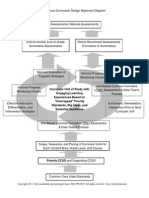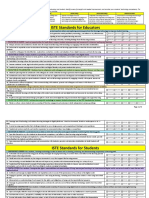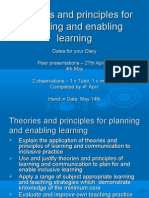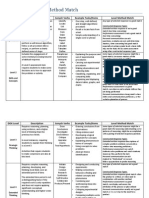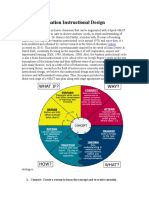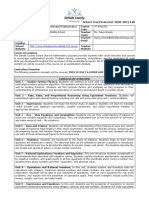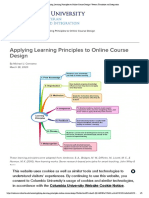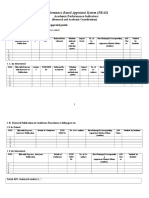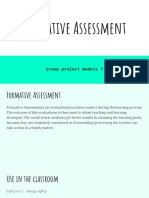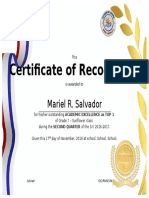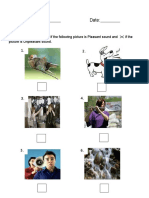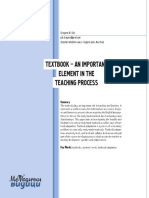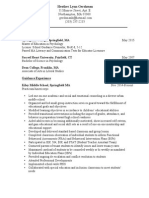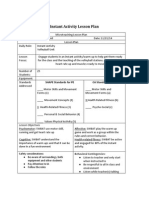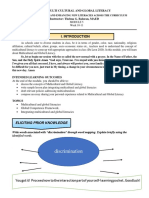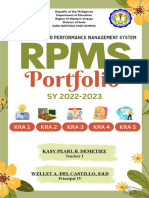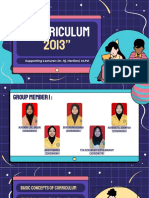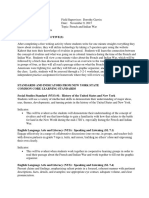Bloom's Revised Taxonomy
Prepared by:
Frederick B. Bambao
�
TAXONOMY
comes from the Greek word
taxis=arrangements and
nomos=science
Science of arrangements
means 'a set of classification principles', or
'structure', and
Domain simply means 'category'.
�Who is BENJAMIN BLOOM?
BENJAMIN SAMUEL BLOOM
(Feb. 1913 Sep.
1999)
was a Jewish-American educational
psychologist.
Contributions:
1. Classification of Educational
Objectives
2. Theory of Mastery-Learning
�Writing Instructional Objectives
objectives,
Instructional
can
be
written for any of the domains of
instruction
Cognitive
The cognitive domain involves the
Domain
learning and application of knowledge.
Affective Domain
The affective domain addresses the
acquisition of attitudes and values.
Psychomotor
The
psychomotor
Domain
domain
involves
development of the body and skills it
performs.
�HOTS
(HIGHER ORDER
THINKING SKILLS)
An
Analizing
E
C
Evaluating
Creating
LOTS
(LOWER ORDER
THINKING
SKILLS)
Remembering
Un
Ap
Understanding
Applying
�ORIGINAL TAXONOMY (1956) ---> REVISED
TAXONOMY (2001)
High
Order
Thinkin
g Skills
Low
Order
Thinkin
g Skills
Knowledge
Comprehension
Analysis
Application
Synthesis
Evaluation
Remember (I know)
Understand (I comprehend)
Apply (I can use it)
Analyze (I can be logical)
Evaluate (I can judge)
6
Create ( I can plan)
�Application of Cognitive
Processes and dimensions
Factual Knowledge
Conceptual
Knowledge
Basic elements used to communicate,
Knowledge
of
classifications
Procedural
Knowledge
understand, organize a subject:
and
categories,
principles,
terminology,
scientific
terms, labels,
Knowing
how
to
do
something:
Metacognitive Knowledge
vocabulary,
jargon,
symbols
or
performing
skills,
algorithms,
theories,
models
or
structures
The process or strategy of learning of
representations;
and
specific
details
techniques
or
methods.
and
thinking;
an
awareness
of
ones
a subject
such cognition,
as knowledge
own
and of
theevents,
ability people,
to
dates, sources
of and
information.
control,
monitor,
regulate ones
own cognitive process.
�Blooms Revised
Taxonomy
.
Internalizing
Organizing
Valuing
Responding
Receiving
Affective
Domain
�Blooms Revised
Taxonomy
Level
Description
.
Verbs
Objective
Receiving
Being aware of, or attending to
something in the environment.
Listen
Notice
Tolerate
Listen attentively to
badminton
introduction.
Responding
Showing some new behavior as
a result of experience.
Comply
Enjoy
Follow
Voluntarily help set up
badminton nets.
Valuing
Showing some definite
involvement or commitment.
Carry out
Express
Attend optional
badminton match.
Organization
Integrating a new value into
one's general set of values
relative to other priorities.
Choose
Consider
Prefer
Purchase own
badminton racket.
Characterization
Acting consistently with the new Act on
value; person is known by the
Depict
value.
Exemplify
Join intramurals to
play badminton twice
per week.
�The Psychomotor Domain
Percepti
on
Set
Process of becoming
aware of objects,
qualities, etc by way of
senses. Basic in situationinterpretation-action
chain leading to motor
activity.
Readiness
for a
particular kind of action
or experience; may be
mental, physical or
emotional.
�The Psychomotor Domain
Guided
Response
Mechanis
m
Overt behavioral act
under guidance of an
instructor, or following
model or set criteria.
Learned response
becomes habitual;
learner has achieved
certain confidence and
proficiency or
performance.
�The Psychomotor Domain
Complex
Overt
Response
Performance of motor
act considered complex
because of movement
pattern required.
Adaptation
Altering motor
activities to meet
demands of
problematic situations.
�The Psychomotor Domain
Originatio
n
Creating new motor
acts or ways of
manipulating materials
out of skills, abilities
and understandings
developed in the
psychomotor area.
�Thank you!
�Blooms Revised
Taxonomy
RE
ME
MB
ERI
NG
REMEMBERING
- Recall previous learned information.
Recalling relevant knowledge from long term
memory.
Rote learning or memorization.
15
�Blooms Revised
Taxonomy
UNDERSTANDING
- Comprehending the meaning,
translation, interpolation, and
interpretation of instructions and
problems. State a problem in one's
own words.
UN
DE
RS
TA
ND
IN
G
- Construct meaning and
explain.
16
�Blooms Revised
Taxonomy
AP
PLY
IN
G
APPLYING
- Use a concept in a new situation or
unprompted use of abstraction.
- applies what was learned in the
classroom into novel situations.
- abstract ideas into practical
situations
17
�Blooms Revised
Taxonomy
AN
ALY
ZIN
G
ANALYZING
- Breaking the concept into parts
and understand how each
part is
related to one another.
- Illustrate relationships to
one another.
18
�Blooms Revised
Taxonomy
EV
AL
UA
TIN
G
EVALUATING
Making judgments based on a set of
guidelines
and the value of ideas or materials.
Judge, criticize and assess
information using what you know to
make decisions and
support your
views.
19
�Blooms Revised
Taxonomy
CR
EA
TI
NG
CREATING
- Builds a structure or
pattern
from diverse elements. Put
parts together to form a
whole,
with emphasis on creating
a
new meaning or structure.
way.
20
�Blooms Revised
Taxonomy
21















